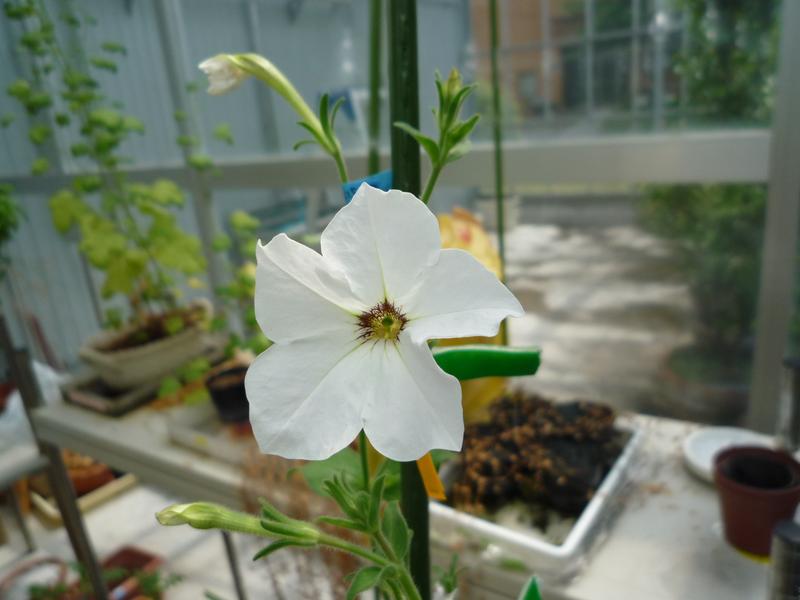

Petunia flower.
image: Hiroyuki Kakui
The ability of many plant species to recognize and reject one’s own pollen enables them to avoid inbreeding as genetic defects can occur in offspring. Plants recognize their own pollen by a molecular mechanism, known as ‘self-incompatibility’ or ‘SI’. Previous studies revealed that plants and animals have evolved so-called one-to-one self-recognition systems where a single male protein is capable of recognizing a single female protein which can trigger a pollen rejection response.
A team of plant scientists from the Institute of Evolutionary Biology and Environmental Studies at the University of Zurich headed by Professor Kentaro Shimizu has previously studied the one-to-one SI system in the model plant Arabidopsis.
The researchers at UZH and their collaborators from the Nara Institute in Japan have described a new SI system in petunias that is unlike the previously studied one-to-one self-rejection systems in other plants. Using state-of-the-art sequencing methods, Dr. Timothy Paape at UZH and Dr. Ken-ichi Kubo and colleagues from Japan are the first to demonstrate that the petunia system is highly complex. Petunias, which are members of the Solanaceae family (nightshades), do not use a one male and one female protein recognition system, but rather many proteins are involved in self-recognition process of SI.
In total, 18 male proteins recognize 40 female proteins which are toxic to the plant’s own pollen and thus prevent fertilization. “This self-incompatibility system is the largest one discovered in any plant species,” says Paape. “Our large-scale study allows us to answer many long-standing questions about the evolutionary genetics of RNase based SI because the corresponding genetic diversity in both male and female genes is very different.” The report was featured by the cover picture of the premier issue of Nature Plants.
Complex recognition interplay
The self-incompatibility mechanism shows similarities to disease recognition in animal immune systems, where the organism’s own proteins identify and detoxify harmful pathogens. Proteins that are encoded by self-incompatibility genes (S-genes) are involved in the self-recognition process. As the UZH plant scientists write in their publication in Nature Plants, the exact interplay between the male, termed SLF proteins (S-locus F-box proteins), and female proteins, known as S-RNases (S-ribonucleases) is highly complex in petunias. In petunias, often a single male protein recognizes and detoxifies several female proteins while in other cases a single female protein is recognized by only a few male proteins.
“Complex defense and genetic recognition mechanisms are difficult to study in animals because it is challenging to identify the interacting genes in both the host and the pathogen. The S-RNase based SI system in Petunia shows similar evolutionary patterns to what we expect for immune defense systems in vertebrates, including humans,” says Paape. “The identification of the corresponding male and female SI genes allows us to study how a complex recognition system evolves and is maintained at the genetic level.”
Big plus for breeding
Understanding the genetics of SI is also important in plant breeding. “It might be useful for breeders to obtain yields from vital hybrids while at the same time there can be a risk that no fruit will be produced if fertilization is prevented,” explains Professor Shimizu. The researchers also reported a similar number of male SLF protein types in potatoes and tomatoes, both important crop species also in the nightshade family. A similar S-RNase based SI systems is also present in important fruit trees not in the nightshade family, such as apples and pears. Identifiying the relevant genes that directly affect crop yields could provide useful tools for plant breeders.
Broad support for the study
The study was conducted within the scope of UZH’s University Research Priority Program (URPP) Evolution in Action: From Genomes to Ecosystems, and was supported by Swiss National Science Foundation and by Plant Fellow. The group headed by Professor Kentaro Shimizu performed the comprehensive sequencing of the petunia’s pollen DNA (Rie Shimizu-Inatsugi), the bioinformatics analyses at the Funcaitonal Genomics Center Zurich (Masaomi Hatakeyama) and the evolutionary analyses (Timothy Paape). The team from the Nara Institute of Science and Technology, Japan, was responsible for the experimental and sequence analysis.
Literature:
Ken-ichi Kubo, Timothy Paape, Masaomi Hatakeyama, Tetsuyuki Entani, Akie Takara, Kie Kajihara, Mai Tsukahara, Rie Shimizu-Inatsugi, Kentaro K. Shimizu* and Seiji Takayama*. Gene duplication and genetic exchange drive the evolution of S-RNase-based self-incompatibility in Petunia. Nature Plants. January 8, 2015. DOI: 10.1038/NPLANTS.2014.5
* Corresponding authors
Contacts:
Dr. Timothy Paape
Institute of Evolutionary Biology and Environmental Studies
University of Zurich
Tel.:+41 44 635 49 86
Email: tim.paape@ieu.uzh.ch
Prof. Kentaro K. Shimizu
Institute of Evolutionary Biology and Environmental Studies
University of Zurich
Tel.: +41 44 635 67 40 or +41 44 635 49 70
Email: kentaro.shimizu@ieu.uzh.ch
Bettina Jakob
Media Relations
University of Zurich
Tel.: +41 44 634 44 39
Email: bettina.jakob@kommunikation.uzh.ch
http://www.mediadesk.uzh.ch/articles/2015/ausgekluegeltes-system-verhindert-bei-…












